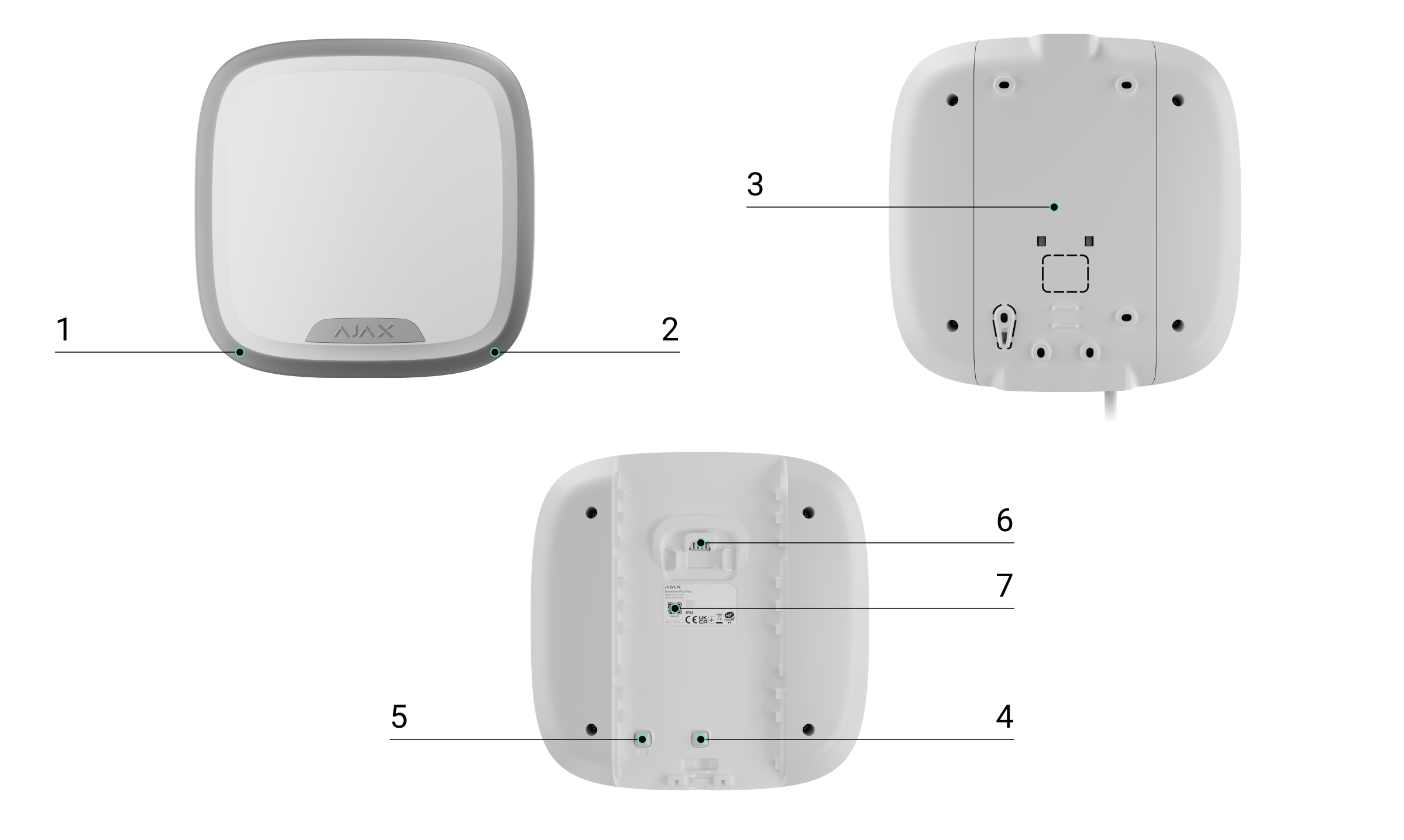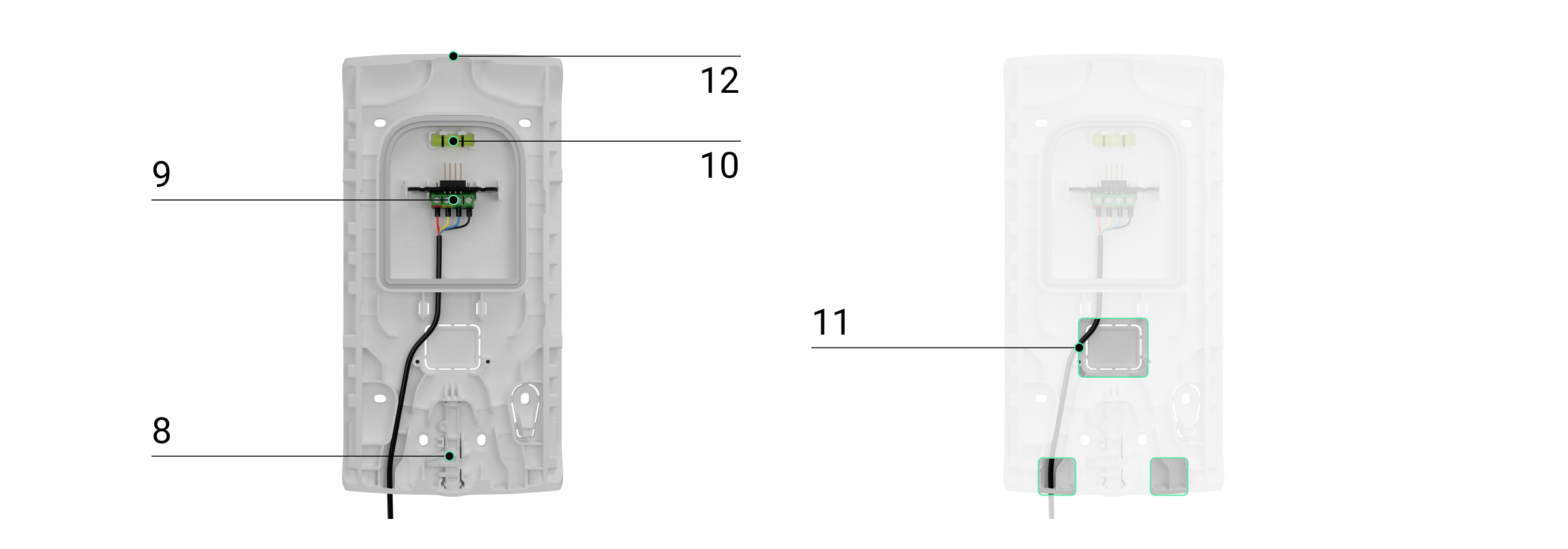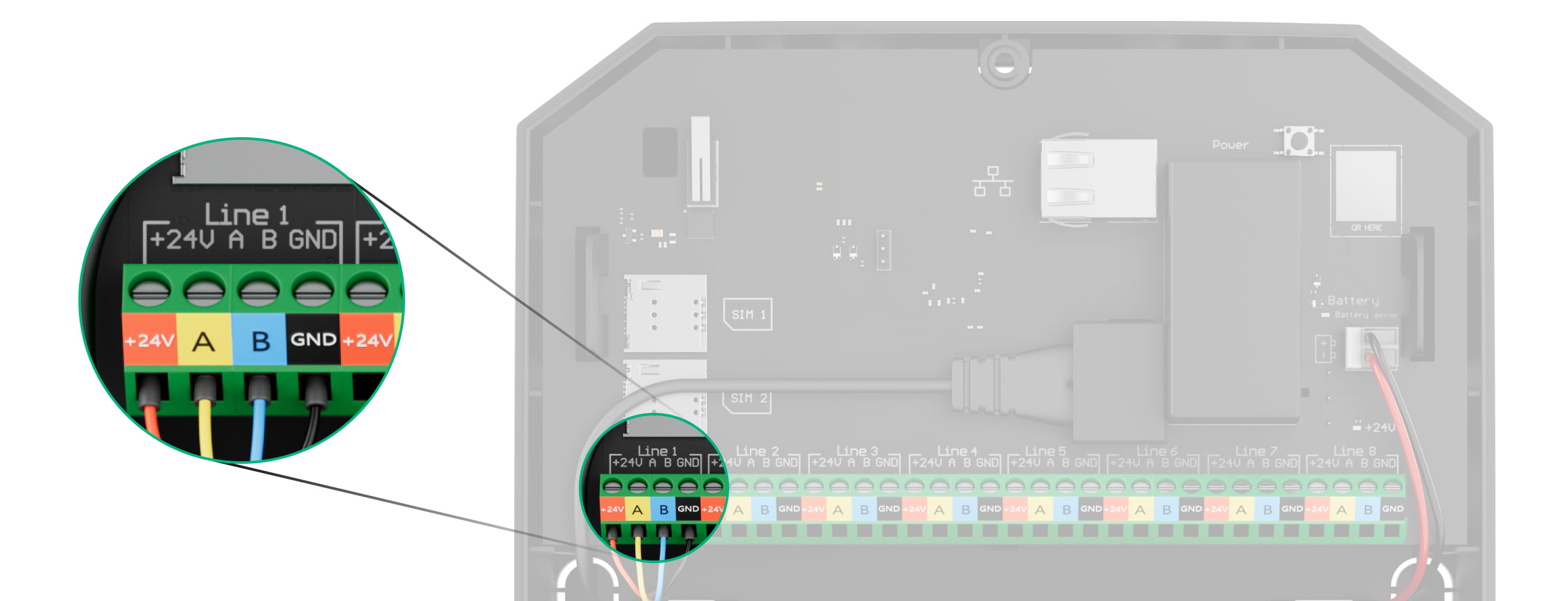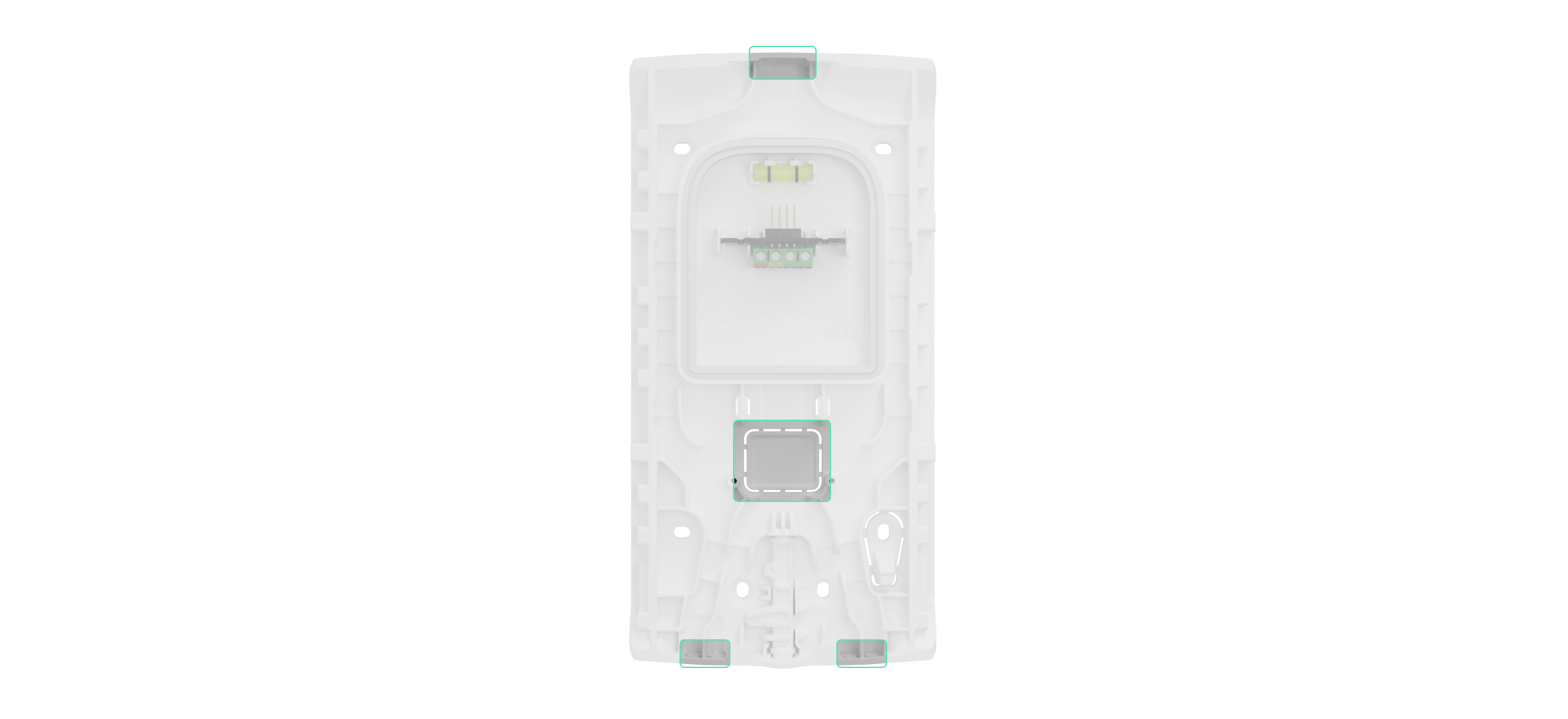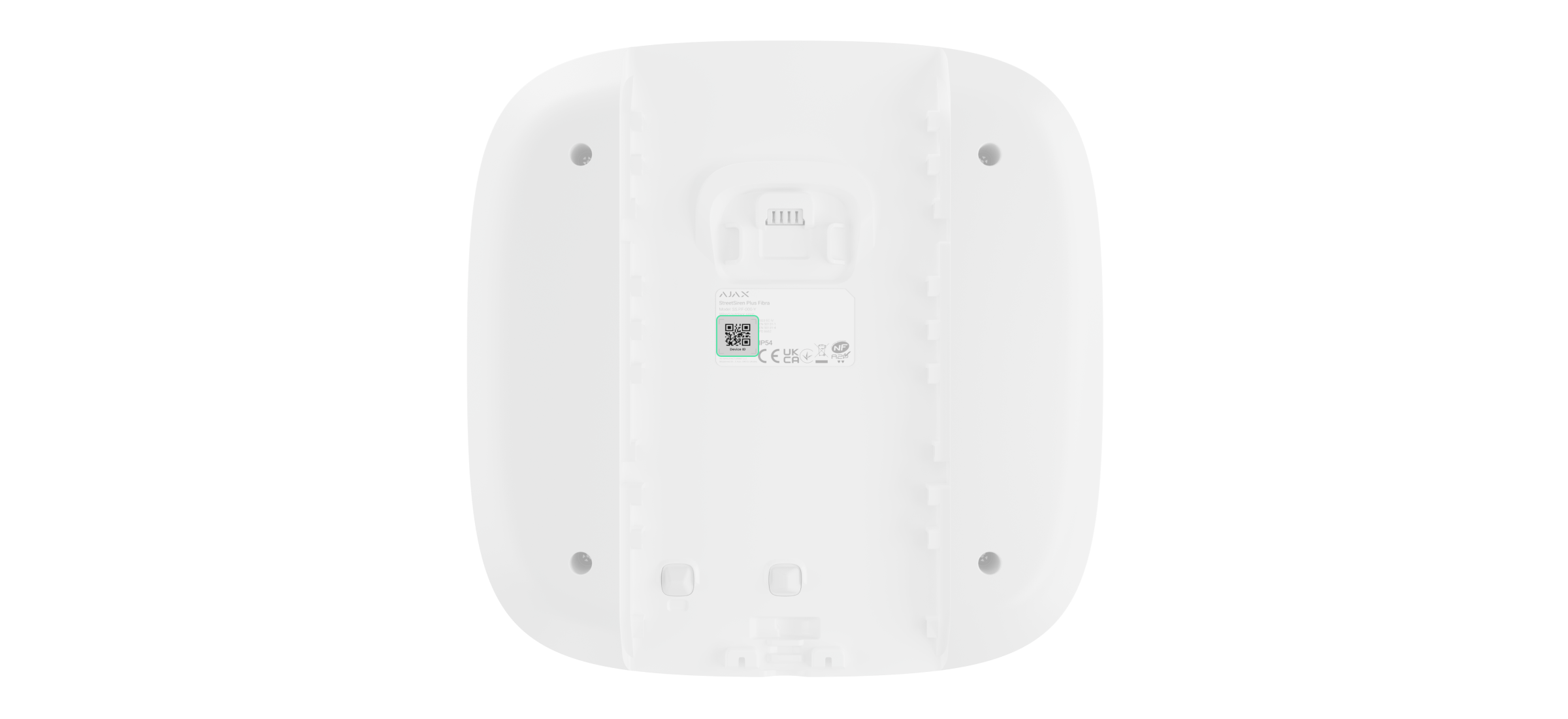Superior StreetSiren Plus Fibra é uma sirene com fios melhorada para utilização no exterior e no interior. Equipada com uma moldura LED e um altifalante que produz um volume de som até 107 dB. Para instalação no interior e no exterior.
Superior StreetSiren Plus Fibra funciona como parte do sistema Ajax, trocando dados com o hub através do protocolo seguro da tecnologia Fibra com fios. O alcance da comunicação é de até 2000 m quando conectado através de um cabo de par entrançado U/UTP cat.5. A sirene tem uma bateria selada utilizada para alimentar o dispositivo. A bateria é carregada a partir da linha Fibra e é utilizada para indicação e notificação de alarmes e eventos.
Em caso de avaria da linha Fibra ou de falta de energia elétrica de emergência, a bateria de reserva fornecerá à sirene energia para indicar e alertar alarmes e eventos.
Superior StreetSiren Plus Fibra é um dispositivo da linha de produtos com fios Fibra. A instalação, venda e administração destes dispositivos são efetuadas apenas por parceiros Ajax acreditados.
Elementos funcionais
- Moldura LED.
- Indicador LED no canto inferior direito da sirene.
- Painel de instalação SmartBracket.
- Primeiro tamper. Aciona em caso de desbloqueio da sirene do SmartBracket.
- Segundo tamper. Aciona em caso de tentativa de desprender o detetor da superfície ou do SmartBracket.
- Contactos na sirene para conexão ao hub.
- Código QR com o ID/número de série do dispositivo.
- Bloqueio para SmartBracket. É utilizado para fixar o dispositivo no painel SmartBracket.
- Terminais de conexão da sirene a uma linha Fibra.
- Nível de bolha para verificar o ângulo de inclinação da montagem durante a instalação.
- Peças perfuradas para passar os fios.
- Recortes para efetuar os furos de forma cómoda.
Princípio do funcionamento
A Sirene executa quatro tarefas:
- Informa sobre os alarmes. A sirene responde aos alarmes do sistema e ao acionamento de um tamper ativando um altifalante e uma retroiluminação LED, que afugenta os intrusos e chama a atenção.
- Indica o estado da segurança. A sirene informa os utilizadores sobre atrasos ao entrar/sair com um sinal sonoro e retroiluminação.
- Avisa da abertura (Chimes). As sirenes com um som específico informam-no do acionamento dos detetores de abertura quando o sistema é desarmado. A funcionalidade é utilizada, por exemplo, em lojas, para notificar os empregados de que alguém entrou no edifício.
- Notifica o acionamento até o sistema ser desarmado. Após o sinal sonoro, o indicador LED no canto inferior direito da sirene começa a piscar. Graças a esta opção, os utilizadores e as patrulhas de passagem das empresas de segurança podem ver que o sistema foi acionado.
Volume e duração do alarme
Durante alarme, a sirene toca de 3 segundos a 3 minutos, emitindo um volume sonoro de 85 a 107 dB. Nas apps Ajax, o utilizador pode definir a duração e o volume do alarme, bem como determinar quais os dispositivos que ativarão a sirene.
Proteção contra sabotagem
Superior StreetSiren Plus Fibra está equipada com um botão de tamper e dispara o alarme quando a alimentação principal (da linha Fibra) é perdida. O tamper é acionado quando a sirene é retirada do suporte e quando a carcaça é aberta ou danificada.
Em caso de sabotagem, os utilizadores e a empresa de segurança sabem exatamente qual a sirene que os intrusos estão a tentar desativar. As notificações contêm o nome do hub (nome do objeto protegido), a hora do incidente, o nome da sirene, o tipo de alarme e a sala virtual à qual o dispositivo está atribuído.
Superior StreetSiren Plus Fibra tem uma bateria pré-instalada. Fornece à sirene a potência para indicar e notificar alarmes e eventos, bem como em caso de danos na linha Fibra ou de falta de energia elétrica de emergência.
Protocolo de transferência de dados Fibra

A sirene utiliza a tecnologia Fibra para transmitir os alarmes e os eventos. Este é um protocolo de transferência de dados com fios que proporciona uma comunicação bidirecional rápida e fiável entre o hub e os dispositivos conectados. Utilizando o método de conexão por bus, Fibra fornece alarmes e eventos instantaneamente, mesmo que estejam conectados 100 dispositivos ao sistema.
Fibra suporta a encriptação de blocos com uma chave flutuante e verifica cada sessão de comunicação com os dispositivos para evitar sabotagem e falsificação. O protocolo requer a consulta regular dos dispositivos pelo hub com uma frequência pré-determinada para monitorizar a comunicação e apresentar o estado dos dispositivos do sistema nas apps Ajax.
Envio de eventos para a central de monitorização
O sistema Ajax pode transmitir alarmes para a app de monitorização PRO Desktop, bem como para a central recetora de alarmes (CRA) utilizando SurGard (Contact ID), SIA (DC-09), ADEMCO 685 e outros protocolos.
Superior StreetSiren Plus Fibra pode transmitir os seguintes eventos:
- Tampa aberta/fechada.
- Painel de instalação bloqueado/desbloqueado.
- Alarme devido a perda/recuperação da alimentação elétrica principal.
- Perda/recuperação da conexão entre a Superior StreetSiren Plus Fibra e o hub.
- Desligar/ligar a sirene.
- Descarga/carga da bateria.
- Desconexão/conexão da bateria.
Quando um alarme é recebido, o operador da estação de monitorização da empresa de segurança sabe o que aconteceu e para onde deve ser enviada a unidade de resposta rápida. A capacidade de endereçamento dos dispositivos Ajax permite-lhe transmitir à PRO Desktop e à CRA eventos, tipo de dispositivo, nome atribuído e localização (sala, grupo). A lista de parâmetros transmitidos pode variar consoante o tipo de CRA e o protocolo de comunicação selecionado.
O ID do dispositivo, o número do bucle (zona), bem como o número da linha podem ser encontrados nos seus estados.
Seleção do local de instalação
Ao escolher o local de instalação da Superior StreetSiren Plus Fibra, tenha em conta os parâmetros que afetam o funcionamento da sirene:
- Intensidade do sinal Fibra.
- Comprimento do cabo para conexão da Superior StreetSiren Plus Fibra.
- Audibilidade do sinal sonoro da Superior StreetSiren Plus Fibra.
- Visibilidade da indicação LED da Superior StreetSiren Plus Fibra.
Superior StreetSiren Plus Fibra resiste ao calor, ao frio e às variações de temperatura. A sirene está protegida da chuva e da neve e pode ser instalada na fachada do edifício sem cobertura. A carcaça da sirene tem uma classe de proteção IP54.
A altura de instalação recomendada é de 2,5 metros ou mais. Isso dificulta o acesso de intrusos ao dispositivo no caso de uma tentativa de sabotagem. Se a sirene não puder ser colocada a esta altura, pode ser instalada mais abaixo.
Siga as recomendações de colocação ao conceber o sistema Ajax para um objeto. O sistema de segurança deve ser concebido e instalado por profissionais. A lista de parceiros Ajax autorizados está disponível aqui.
Não instale a sirene
- Perto de detetores de quebra de vidros. O som da sirene pode acionar um alarme.
- Em locais onde o sinal áudio da sirene possa ser abafado.
- Em locais onde a indicação LED da sirene não seja visível.
- Em locais com uma intensidade de sinal Fibra baixa ou instável.
Intensidade do sinal Fibra
A intensidade do sinal Fibra é determinada pelo rácio entre o número de pacotes de dados não entregues ou corrompidos e os esperados durante um determinado período de tempo. O ícone no separador Dispositivos
nas apps Ajax indica a intensidade do sinal:
- Três barras — excelente intensidade de sinal.
- Duas barras — boa intensidade de sinal.
- Uma barra — fraca intensidade de sinal, não é garantido um funcionamento estável.
- Ícone riscado — sem sinal; o funcionamento estável não é garantido.
Os seguintes fatores afetam a intensidade do sinal:
- O número de dispositivos conectados a uma linha Fibra.
- Comprimento e tipo do cabo.
- A conexão correta dos cabos aos terminais.
Conceção
Para instalar e configurar corretamente os dispositivos, é importante conceber corretamente o sistema. A conceção deve ter em conta o número e os tipos de dispositivos no objeto, a sua localização exata e a altura de instalação, o comprimento dos cabos Fibra, o tipo de cabo utilizado e outros parâmetros. Este artigo apresenta sugestões para a conceção de sistemas Fibra com fios.
Topologias
Os sistemas Ajax suportam três topologias: Feixe (cablagem radial), Árvore e Anel.
A ligação do Feixe ocupa uma linha de saída do hub. No caso de uma quebra de linha, apenas o segmento que permanece fisicamente conectado ao hub funcionará. Todos os dispositivos conectados após o ponto de interrupção perderão a conexão com o hub.
O método de ligação por anel ocupa duas saídas de linha do hub. Se o anel se partir num único local, nenhum dispositivo será desativado. O anel reconfigura-se em duas linhas, que continuam a funcionar normalmente. Os utilizadores e a empresa de segurança receberão uma notificação sobre a rotura.
| Feixe (Cablagem radial) | Anel |
| Ocupa uma saída de linha do hub. Até 8 linhas no mesmo hub. Até 2000 m de comunicação por cabo para a mesma linha. É instalada uma resistência de terminação no final da linha. |
Ocupa duas saídas de linha do hub. Até 4 anéis no mesmo hub. Até 500 m de comunicação por cabo para o mesmo anel. Não é instalada qualquer resistência de terminação no final da linha. |
Ambas as topologias de ligação de dispositivos podem ser utilizadas no mesmo hub. Por exemplo, pode utilizar duas ligações por Anel e quatro ligações de topologia de Feixe.
Podem ser conectados diferentes tipos de dispositivos a uma única linha Fibra. Por exemplo, pode conectar detetores de abertura, detetores de movimento com suporte de verificação fotográfica, sirenes e teclados à mesma linha.
Para a topologia Feixe (Radial), certifique-se de que instala uma resistência de terminação de 120 Ohm na extremidade da linha (incluída no conjunto completo do hub). A resistência de terminação é conectada aos terminais de sinal do último dispositivo na linha.
A ramificação de linhas e a topologia de árvore só são permitidas quando se utiliza Superior LineSplit Fibra.
Comprimento e tipo do cabo
O alcance máximo de comunicação para a conexão com fios utilizando a topologia de Feixe (Radial) é de 2000 metros, e o da topologia por Anel é de 500 metros.
Tipos de cabos recomendados:
- Cabo U/UTP cat.5 4×2×0,51 mm (24 AWG), condutor de cobre;
- Cabo de sinal 4 × 0,22 mm², condutor de cobre.
Se utilizar um tipo de cabo diferente, o alcance da comunicação para conexões com fios pode variar. Não foram testados outros tipos de cabos.
Verificação com um calculador

Para garantir que o projeto é calculado corretamente e que um sistema deste tipo funciona na prática, desenvolvemos um Calculador de distâncias de linhas Fibra. O calculador ajuda a verificar a qualidade da comunicação e o comprimento do cabo para dispositivos Fibra com fios com a configuração selecionada na fase de conceção do sistema.
Preparar a instalação
Organização dos cabos
Ao preparar a passagem dos cabos, verifique os regulamentos de segurança elétrica e contra incêndios da sua região. Respeite rigorosamente estas normas e regulamentos.
É mais seguro colocar os cabos no interior das paredes, do chão e do teto; desta forma, ficarão invisíveis e indisponíveis para os intrusos. Garante também uma maior durabilidade: o cabo será afetado por menos fatores externos que podem afetar o desgaste do condutor e da sua camada isolante.
Normalmente, os cabos do sistema são instalados durante a fase de construção ou reparação, após a cablagem do local.
Se não for possível instalar os cabos no interior das paredes, coloque-os de forma a ficarem suficientemente protegidos e escondidos de olhares indiscretos. Por exemplo, numa conduta de cabos ou num tubo corrugado de proteção. Recomenda-se a sua ocultação. Por exemplo, atrás dos móveis.
Independentemente de o cabo ser ou não encaminhado para o interior da parede, recomenda-se a utilização de tubos de proteção, condutas de cabos ou tubos corrugados para proteger os cabos. Os cabos devem ser organizados com cuidado; não é permitido que fiquem soltos, emaranhados ou torcidos.
Considere as localizações de possíveis interferências de sinal. Se o cabo for encaminhado perto de motores, geradores, transformadores, linhas elétricas, relés de controlo e outras fontes de interferência eletromagnética, utilize um cabo de par entrançado nessas áreas.
Passagem de cabos
Ao colocar os cabos, tenha em conta não só os requisitos e regras gerais para os trabalhos de instalação elétrica, mas também as especificidades da instalação de cada dispositivo: altura de instalação, método de fixação, forma como o cabo é inserido na caixa e outros parâmetros.
Antes da instalação, recomendamos que leia a secção Seleção do local de instalação deste manual. Evite desvios em relação ao projeto do sistema. A violação das regras básicas de instalação e das recomendações deste manual pode levar a um funcionamento incorreto, bem como à perda de conexão com a Superior StreetSiren Plus Fibra.
Verifique os cabos quanto a dobras e danos físicos antes de os encaminhar. Substitua os cabos danificados.
Os cabos de sinal para os dispositivos do sistema devem ser colocados a uma distância mínima de 50 cm dos cabos de alimentação quando colocados em paralelo, e num ângulo de 90° em caso de interseção.
Respeite o raio de curvatura admissível do cabo. É especificado pelo fabricante nas especificações do cabo. Caso contrário, corre-se o risco de danificar ou partir o condutor.
Preparação dos cabos para conexão
Remova a camada isolante e descasque o cabo com um descascador de isolamento especial. As extremidades dos fios que serão inseridos nos terminais do dispositivo devem ser estanhadas ou cravadas com uma manga. Isto garante uma conexão fiável e protege o condutor da oxidação. Tamanhos de terminais de cabos recomendados: 0,75 a 1 mm².
Instalação e conexão
Conectar a Superior StreetSiren Plus Fibra a um hub
- Desative a alimentação das linhas na app Ajax PRO. A função está disponível no menu linhas:
- Hub → Definições → Linhas → Fonte de alimentação das linhas.
- Introduza o cabo de conexão do dispositivo na carcaça do hub. Conecte os fios à linha do hub necessária.
+24 V — Terminal de alimentação de 24 V⎓.
A, B — terminais de sinal.
GND — terra. - Retire o painel de instalação SmartBracket do dispositivo e corte a parte perfurada para a saída dos cabos da parte inferior da sirene ou através da parede. Opcionalmente, pode utilizar um perfurador para fazer furos de 6 mm na parte Superior do SmartBracket.
- Se a sirene não for o último dispositivo da linha, prepare previamente um segundo cabo. As extremidades dos fios do primeiro e segundo cabos que serão inseridos nos terminais do dispositivo devem ser estanhadas e soldadas.
- Conecte os fios aos terminais de acordo com a figura abaixo. Respeite a polaridade e a ordem de conexão dos fios. Fixe firmemente os fios aos terminais. Fixe o cabo com braçadeiras.
+24V — fase de potência
А, B — terminais de sinal
GND — terra - Se a sirene for o último dispositivo da linha e for utilizada a topologia de ligação por Feixe, instale uma resistência de terminação ligando-a aos terminais de sinal do dispositivo. Quando é utilizada a ligação por Anel, não é necessária uma resistência de terminação.
- Fixe temporariamente o painel SmartBracket a uma superfície vertical. Isto é necessário para efetuar os testes do dispositivo. A altura de instalação recomendada é de 2,5 metros ou mais.
- Coloque o detetor no painel de instalação SmartBracket.
- Ligue a alimentação das linhas na app Ajax PRO (Hub → Definições → Linhas → Fonte de alimentação das linhas). Quando a alimentação é aplicada, a iluminação LED avisa-o de que o dispositivo está ligado.
- Adicione a Superior StreetSiren Plus Fibra ao hub.
- Efetue o Teste de intensidade do sinal Fibra. A intensidade de sinal recomendada é de duas ou três barras. Se a intensidade do sinal for de uma ou zero barras, verifique a correção da conexão e a integridade do cabo.
- Execute o Teste de volume. Se a sirene não for audível o suficiente, ajuste o volume ou reposicione o dispositivo.
- Se a sirene passar nos testes, fixe o painel de instalação SmartBracket com os parafusos fornecidos usando todos os pontos de fixação (um deles está na parte perfurada do suporte acima do tamper).
Não utilize a fita adesiva de dupla face para a fixação da sirene, pois o dispositivo pode descolar-se da superfície a qualquer momento.
- Faça deslizar o dispositivo para o painel de instalação SmartBracket e bloqueie-o. Isto reduz o risco de roubo ou sabotagem do dispositivo.
Adicionar ao sistema
Verifique a compatibilidade do dispositivo antes de adicionar o detetor ao sistema. Apenas os parceiros verificados podem adicionar e configurar dispositivos Fibra nas apps Ajax PRO.
Antes de adicionar um dispositivo
- Instale a app Ajax PRO.
- Inicie sessão numa conta PRO ou crie uma nova conta.
- Selecione um espaço ou crie um novo.
- Adicione pelo menos uma sala virtual.
- Adicione um hub compatível ao espaço. Certifique-se de que o hub está ligado e tem acesso à Internet através de Ethernet, Wi-Fi e/ou rede móvel.
- Certifique-se de que o espaço está desarmado e de que o hub não está a iniciar uma atualização, verificando os estados na app Ajax.
Como adicionar a Superior StreetSiren Plus Fibra
Estão disponíveis duas formas de adicionar dispositivos na app Ajax PRO: automáticamente e manualmente.
Para adicionar a sirene automaticamente:
- Abra a app Ajax PRO. Selecione o hub ao qual pretende adicionar a Superior StreetSiren Plus Fibra.
- Aceda ao separador Dispositivos
e selecione Adicionar dispositivo.
- Selecione Adicionar todos os dispositivos Fibra. O hub vai analisar as linhas Fibra. Após a verificação, são apresentados todos os dispositivos conectados ao hub que ainda não foram adicionados ao sistema.
- Selecione um dispositivo na lista. Depois de premir, o indicador LED piscará para identificar este dispositivo.
- Defina o nome do dispositivo e especifique a sala e o grupo de segurança, se o modo Grupo estiver ativado. Prima Guardar.
Para adicionar uma sirene manualmente:
- Abra a app Ajax PRO. Selecione o hub ao qual pretende adicionar a Superior StreetSiren Plus Fibra.
- Aceda ao separador Dispositivos
e selecione Adicionar dispositivo.
- Dê um nome ao dispositivo.
- Digitalize ou introduza manualmente o código QR. O código QR está localizado na parte de trás da carcaça, sob o painel de instalação SmartBracket e na embalagem.
- Selecione uma sala virtual e um grupo de segurança (se o modo Grupo estiver ativado).
- Prima Adicionar.
Se a conexão falhar, verifique se a conexão com fios está correta e tente novamente. Se o hub já tiver o número máximo de dispositivos adicionados, receberá uma notificação de erro quando adicionar um.
É possível conectar até 10 sirenes ou teclados com sirene integrada ao hub Ajax.
Superior StreetSiren Plus Fibra funciona apenas com um hub. Após a conexão a um novo hub, a sirene deixa de trocar comandos com o antigo. Depois de ser adicionada a um novo hub, a Superior StreetSiren Plus Fibra não é removida da lista de dispositivos do hub antigo.
Teste de funcionalidade
Testes disponíveis para a Superior StreetSiren Plus Fibra:
- Teste de intensidade do sinal Fibra. O teste permite-lhe verificar a intensidade e a estabilidade do sinal no local de instalação.
- Teste de volume. Permite-lhe verificar o nível de volume atual da sirene e selecionar o nível de volume ideal para o objeto protegido.
Para efetuar um teste:
- Selecione um hub na app Ajax PRO.
- Aceda o separador Dispositivos
.
- Selecione Superior StreetSiren Plus Fibra.
- Aceda às definições da Superior StreetSiren Plus Fibra clicando no ícone da engrenagem
.
- Selecione:
- Execute o teste seguindo as instruções da app.
Ícones
Os ícones mostram alguns dos estados do detetor. Pode visualizá-los em apps Ajax:
- Selecione um hub na app Ajax.
- Aceda o separador Dispositivos
.
- Encontre a Superior StreetSiren Plus Fibra na lista.
| Ícone | Significado |
|
Intensidade do sinal Fibra — apresenta a intensidade do sinal entre o hub e a sirene. Valores recomendados: 2–3 barras. |
|
|
O nível de carga da bateria do dispositivo está OK. |
|
| Apresentado se a carga da bateria for igual ou inferior a 20%. | |
| A bateria não está instalada. | |
| Está disponível uma atualização de firmware. | |
| A atualização do firmware falhou. | |
|
Apresentado se o painel de instalação estiver desbloqueado. |
|
|
A sirene avisa da abertura. |
|
|
A sirene é desativada até que, durante algum tempo, o modo armado esteja ativo. |
|
|
A sirene tem os eventos de disparo de tamper desativados durante o tempo em que o modo armado está ativo. |
|
|
A sirene tem os eventos de disparo de tamper permanentemente desativados. |
|
|
A sirene está permanentemente desativada. |
|
| O dispositivo perdeu a ligação com o hub ou o hub perdeu a ligação com o servidor Ajax Cloud. | |
|
O dispositivo não foi transferido para o novo hub. |
Estados
Os estados incluem informações sobre o dispositivo e os seus parâmetros de funcionamento. Os estados da Superior StreetSiren Plus Fibra podem ser encontrados nas apps Ajax:
- Selecione um hub na app Ajax.
- Aceda o separador Dispositivos
.
- Selecione Superior StreetSiren Plus Fibra na lista de dispositivos.
| Parâmetro | Significado |
| Importação de dados | Apresenta o erro aquando da transferência de dados para o novo hub:
|
| Temperatura |
Temperatura do dispositivo. É medida pelo processador e muda consoante a temperatura ambiente. É possível criar um cenário por temperatura para controlar dispositivos de automatização. |
| Intensidade do sinal Fibra |
Intensidade do sinal entre o hub e a Superior StreetSiren Plus Fibra. Valores recomendados: 2–3 barras. Fibra é um protocolo para a transmissão de eventos e alarmes da Superior StreetSiren Plus Fibra. |
| Conexão via Fibra | O estado da conexão entre o hub e a sirene:
|
| Tensão da linha | O valor da tensão na linha Fibra à qual a sirene está conectada. |
| Carga da bateria | Nível de carga da bateria do dispositivo. Estão disponíveis os estados seguintes:
Além disso, a palavra a carregar aparecerá se a bateria estiver a carregar no momento. |
| Tampa | O estado de tamper que responde à separação do dispositivo da superfície ou à violação da integridade da carcaça do dispositivo:
|
| Painel de instalação | O estado do dispositivo de tamper, que reage ao dispositivo de desbloqueio do SmartBracket:
|
| Volume do alarme | Nível de volume em caso de alarme:
O nível do volume é medido a 1 m de distância da sirene. |
| Duração do alarme |
Duração do sinal sonoro em caso de alarme: de 3 segundos a 3 minutos. Define em incrementos de 3 segundos. |
| Indicação LED | Definições da indicação LED da sirene:
|
| Definições de sinais sonoros | |
| Armar/ Desarmar | Quando ativada, a sirene avisa sobre o armar e o desarmar piscando o LED e emitindo um breve sinal sonoro. |
| Ativação/desativação do modo Noturno | Quando ativada, a sirene avisa-o quando o modo Noturno é ligado/desligado, piscando o LED e emitindo um breve sinal sonoro. |
| Atrasosna entrada | Quando a opção está ativada, a sirene sinaliza o Atraso ao entrar com um breve sinal sonoro. |
| Atrasos na saída | Quando a opção está ativada, a sirene assinala o Atraso ao sair com um breve sinal sonoro. |
| Atrasos de entrada no modo Noturno | Quando ativada, a sirene emite um sinal sonoro para assinalar um atraso ao entrar no modo Noturno. |
| Atrasos de saída no modo Noturno | Quando ativada, a sirene emite um sinal sonoro para assinalar um atraso ao sair no modo Noturno. |
| Chime na abertura |
Quando a opção está ativada, a sirene avisa sobre o disparo dos detetores de abertura no modo de sistema Desarmado. |
| Volume do sinal sonoro | Volume do sinal de aviso sonoro sobre armar/desarmar, atraso de entrada/saída, ativação do detetor de abertura:
O nível do volume é medido a 1 m de distância da sirene. |
| Desativação permanente | Mostra o estado da função de desativação do dispositivo:
|
| Desativação única | Apresenta o estado da definição de desativação única do dispositivo:
|
| Firmware | Versão de firmware atual. |
| ID do dispositivo | ID da sirene/número de série. Também disponível no verso da carcaça da sirene e na sua embalagem. |
| Número do Dispositivo | Número do bucle (zona) do dispositivo. |
| Linha nº. | O número da linha Fibra do hub à qual a sirene está conectada. |
Definições
Para alterar as definições da sirene na app Ajax:
- Aceda o separador Dispositivos
.
- Selecione Superior StreetSiren Plus Fibra na lista de dispositivos.
- Aceda a Definições clicando no ícone de engrenagem
.
- Defina as definições necessárias.
- Clique em Voltar para guardar as novas definições.
| Definições | Significado |
| Nome |
Nome da sirene. Apresentado na lista de dispositivos do hub, texto SMS e notificações no historial de eventos. Para alterar o nome, clique no campo de texto. O nome pode conter até 12 caracteres cirílicos ou até 24 caracteres latinos. |
| Sala |
Escolha a sala virtual da Superior StreetSiren Plus Fibra. O nome da sala aparece no texto do SMS e nas notificações no historial de eventos. |
| Notificar se a temperatura do dispositivo estiver fora do intervalo normal |
Quando ativada, o sistema envia notificações sobre as alterações de temperatura que afetam o carregamento da bateria. Esta definição está ativada por defeito. |
| Alarmes sonoros | Selecionar quando ativar o alarme sonoro:
|
| Alarmes em modo de grupo | Seleção do grupo ao qual a sirene está atribuída. É possível selecionar um ou todos os grupos:
Independentemente do grupo selecionado, a sirene responderá à ativação e aos alarmes do modo Noturno. A opção é apresentada se o modo de grupo estiver ativado no hub. |
| Volume do alarme | Nível de volume em caso de alarme:
O nível do volume é medido a 1 m de distância da sirene. |
| Duração do alarme |
Duração do sinal sonoro em caso de alarme: de 3 segundos a 3 ou minutos. Define em incrementos de 3 segundos. |
| Som de alarme | Permite selecionar o tipo de sinal de alarme:
|
| Indicação LED | Definições da indicação LED da sirene:
|
| Tipo de indicação LED | É possível escolher entre seguintes tipos de indicação LED:
|
| Definições de sinais sonoros |
Abre as definições dos sinais sonoros da sirene. A descrição de todas as definições de alerta está disponível abaixo. |
| Ativar o sinal sonoro | |
| Se a tampa estiver aberta | Quando esta opção está ativada, a sirene é acionada ao detetar uma violação do tamper. |
| Se a alimentação elétrica de uma linha for insuficiente | Quando ativada, a sirene será ativada quando for detetada uma perda de energia principal. |
| Atualizações de firmware | Passa o dispositivo para o modo de atualização do firmware se uma nova versão estiver disponível. |
| Teste de intensidade do sinal Fibra |
Passa o dispositivo para o modo de teste da intensidade do sinal Fibra. O teste permite-lhe verificar a intensidade do sinal entre o hub e o detetor através do protocolo de transferência de dados com fios Fibra para determinar o local de instalação ideal. |
| Teste de volume |
Passa a sirene para o modo de teste de volume. O teste permite-lhe verificar o nível de volume atual da sirene e selecionar o nível de volume ideal para o objeto protegido. |
| Guia do utilizador | Abre o Manual do Utilizador da Superior StreetSiren Plus Fibra na app Ajax. |
| Desativação permanente |
Permite ao utilizador desconectar o dispositivo sem o retirar do sistema. Estão disponíveis três opções:
|
| Desativação única |
Permite ao utilizador desativar os eventos do dispositivo até ao primeiro desarme. Estão disponíveis três opções:
|
| Eliminar dispositivo | Desemparelha a Superior StreetSiren Plus Fibra, desconecta-a do hub e elimina as suas definições. |
Definições de sinais sonoros
Bipe na mudança de modo armado
| Evento | Descrição | Nota |
| Armar/ Desarmar | Quando ativada, a sirene avisa-o quando o sistema está armado e desarmado, acendendo a moldura de LED e emitindo um breve sinal sonoro. | A indicação LED e o volume do sinal sonoro dependem das configurações da sirene. A indicação luminosa e/ou sonora pode ser desativada nas definições da sirene. |
| Ativação/desativação do modo Noturno | Quando ativada, a sirene avisa-o quando o modo Noturno é ligado/desligado, acendendo a moldura de LED e emitindo um breve sinal sonoro. | A indicação LED e o volume do sinal sonoro dependem das configurações da sirene. A indicação luminosa e/ou sonora pode ser desativada nas definições da sirene. |
| Silenciar o dispositivo quando o código no teclado está a ser introduzido | Quando ativada, a sirene deixa de emitir os sinais sonoros de atraso ou quaisquer outros avisos quando o utilizador começa a introduzir o código no teclado. |
Bipe no atraso
| Atrasos na entrada |
Quando ativada, a sirene emite um sinal sonoro para assinalar um atraso na entrada. |
| Atrasos na saída |
Quando ativada, a sirene emite um sinal sonoro para assinalar um atraso ao sair. |
| Atrasos de entrada no modo Noturno |
Quando ativada, a sirene emite um sinal sonoro para assinalar um atraso ao entrar no modo Noturno. |
| Atrasos de saída no modo Noturno |
Quando ativada, a sirene emite um sinal sonoro para assinalar um atraso ao sair no modo Noturno. |
Bipe rápido nos atrasos
| Bipe rápido na expiração do atraso de Entrada | Notifica o utilizador de que o tempo de Atraso ao entrar está a terminar. Existem 4 opções para escolher quando o bipe rápido deve começar:
|
| Bipe rápido na expiração do atraso de Saída | Notifica o utilizador de que o tempo de Atraso ao sair está a terminar. Existem 4 opções para escolher quando o bipe rápido deve começar:
|
Bipe quando desarmado
| Chime na abertura |
Quando esta opção está ativada, a sirene informa-o com um breve sinal sonoro de que os detetores de abertura são acionados no modo de sistema Desarmado. |
Volume do sinal sonoro
| Volume do sinal sonoro | Seleção do nível de volume da sirene para notificações sobre armar/desarmar, atraso de entrada/saída e abertura:
O nível do volume é medido a 1 m de distância da sirene. |
Definir a resposta da sirene aos alarmes do dispositivo
Nas app Ajax, é possível configurar separadamente a reação da sirene aos alarmes de cada detetor do sistema. A função é útil se não for necessário ativar a sirene em caso de alarme de um determinado dispositivo. Por exemplo, através do acionamento do detetor de fugas LeaksProtect Jeweller.
Para definir a resposta da sirene a um alarme de dispositivo
- Abra a app Ajax.
- Aceda o separador Dispositivos
.
- Selecione o dispositivo da lista para o qual se pretende configurar a resposta da sirene.
- Aceda às Definições do dispositivo clicando no ícone de engrenagem
.
- Localize a opção Alertar com sirene e selecione os botões que a ativarão. Ative ou desative a função.
- Repita os passos 3-5 para os restantes dispositivos do sistema.
Por defeito, a resposta da sirene é ativada para alarmes de todos os dispositivos no sistema.
Definição da resposta do alarme de tamper
Nas apps Ajax, é possível configurar a resposta da sirene aos alarmes de carcaça de cada dispositivo do sistema. Quando a função está ativada, a sirene emite um sinal sonoro ao acionar o botão de tamper do dispositivo.
Para definir a resposta da sirene a um alarme de tamper
- Abra a app Ajax.
- Aceda o separador Dispositivos
.
- Selecione um hub e aceda às respetivas Definições
.
- Aceda ao menu Serviço.
- Aceda a secção Sons e Alertas.
- Ative a opção Alertar com sirene se a tampa do hub ou do detetor estiver aberta.
- Clique em Voltar para guardar as novas definições.
O botão de tamper reage à abertura e ao fecho da carcaça, independentemente do modo de armado do dispositivo ou sistema.
Definir a resposta ao premir o botão de pânico na app Ajax
É possível configurar a resposta da sirene ao alarme quando o botão de pânico é premido nas apps Ajax.
Para configurar a resposta da sirene ao premir o botão de pânico em apps Ajax
- Abra a app Ajax.
- Aceda o separador Dispositivos
.
- Selecione um hub e aceda às respetivas Definições
.
- Aceda ao menu Serviço.
- Aceda a secção Sons e Alertas.
- Ative a opção Alertar com uma sirene se o botão de pânico na app for premido.
- Clique em Voltar para guardar as novas definições.
Ajustes da indicação de pós-alarme da sirene
A sirene pode informar sobre o acionamento de um sistema armado por meio de uma indicação LED.
A opção funciona da seguinte forma:
- O sistema regista o alarme.
- A sirene toca o alarme. A duração e o volume do sinal dependem das definições do dispositivo.
- A sirene utiliza uma indicação luminosa com um padrão de acordo com a definição do tipo de indicação LED:
- O indicador LED no canto inferior direito pisca duas vezes, aproximadamente a cada 3 segundos.
- Toda a moldura do LED pisca uma vez, aproximadamente a cada 15 segundos (se o nível de carga da bateria for suficiente).
A indicação continuará até que o sistema seja desarmado.
Graças a esta funcionalidade, os utilizadores do sistema e as patrulhas das empresas de segurança que passam podem ver que o sistema foi acionado.
A indicação de pós-alarme da sirene não funciona para detetores sempre ativos, se o detetor foi acionado quando o sistema estava desarmado.
Para ativar a indicação da sirene após o alarme, na app Ajax PRO:
- Aceda às definições da sirene:
- Hub → Definições → Serviço → Sons e Alertas.
- Especifique quais os eventos que as sirenes informarão através de um duplo piscar do indicador LED antes do sistema ser desarmado:
- Alarme de intrusão/emergência confirmado.
- Alarme de intrusão/emergência único.
- Abertura da tampa.
- Prima Selecionar Dispositivos e selecione as sirenes pretendidas. Os novos parâmetros serão guardados.
- Clique em Voltar. Todas as definições serão aplicadas.
Definição de alertas específicos sobre o Cancelamento de Alarmes e a Interrupção de Alarmes
Nas apps Ajax PRO, pode definir quais os dispositivos que devem emitir um sinal sonoro se o alarme for cancelado e quais os dispositivos que devem emitir um sinal sonoro se o alarme for interrompido nas definições do hub. As funcionalidades Aviso de Cancelamento de Alarme e Aviso de Interrupção de Alarme são necessárias para os sistemas que devem cumprir a norma ANSI/SIA CP-01-2019*.
Para selecionar dispositivos a anunciar no cancelamento e interrupção de alarmes, na app Ajax PRO:
- Selecione o hub necessário e vá para:
- Definições
→ Serviço → Processo de armar/desarmar
- Definições
- Certifique-se de que ANSI/SIA CP-01-2019 está selecionada para a definição Conformidade com a Norma.
- Selecione os dispositivos para as opções Alerta específico no cancelamento de alarme e Alerta específico na interrupção de alarme.
- Toque em Voltar para aplicar as definições.
* A Superior StreetSiren Plus Fibra não está certificada de acordo com a norma ANSI/SIA CP-01-2019.
Como configurar o Chime
Se a opção Chime na abertura estiver ativada, a sirene informa-o com um breve sinal sonoro se os detetores de abertura forem acionados quando o sistema estiver desarmado. A funcionalidade é utilizada, por exemplo, em lojas, para notificar os funcionários de que alguém entrou no edifício.
As notificações são configuradas em duas fases: configuração da sirene e configuração dos detetores de abertura.
Para configurar uma sirene
- Aceda o separador Dispositivos
.
- Selecione a sirene pretendida na lista.
- Aceda às Definições clicando no ícone de engrenagem
no canto Superior direito.
- Aceda ao menu Definições de sinais sonoros.
- Desça a página e ative a opção Chime na abertura na categoria Bipe quando desarmado.
- Defina o volume dos sinais sonoros. Estão disponíveis 3 opções (o nível de volume foi medido a uma distância de 1 metro da sirene):
- Baixo — 85 dB.
- Alto — 97 dB.
- Muito alto — 107 dB.
O Volume do sinal sonoro especificado também se aplica ao volume dos sinais sonoros ao armar/desarmar e ao atraso ao entrar/sair.
- Clique Voltar duas vezes para guardar as definições.
- Configure o detetor de abertura.
Indicação
| Evento | Indicação | Nota |
| Alarme | A sirene emite um sinal sonoro e a moldura do LED pisca a vermelho. | A duração e o volume do sinal sonoro dependem da configuração da sirene. |
|
É detetado um alarme no sistema armado (se a indicação de pós-alarme estiver ligada) |
A moldura LED da sirene pisca duas vezes a vermelho no canto inferior direito, cerca de cada 3 segundos, até o sistema ser desarmado. Se a Retroiluminação da moldura completa estiver ativada, todo o quadro LED pisca a vermelho uma vez em cada 15 segundos. |
A indicação acende-se após a sirene ter reproduzido completamente o sinal de alarme. |
|
O sistema está armado (se Bipe na mudança do modo armado estiver ativado) |
A moldura do LED pisca uma vez e a sirene emite um breve sinal sonoro. | O volume do sinal sonoro depende das Definições de volume de sinais sonoros. |
|
O sistema está desarmado (se Bipe na mudança do modo armado estiver ativado) |
A moldura do LED pisca duas vezes e a sirene emite dois sinais sonoros curtos. | O volume do sinal sonoro depende das Definições de volume de sinais sonoros. |
|
Sirene em modo armado (se a indicação estiver configurada no modo Armado) |
A moldura LED no canto inferior direito pisca de 3 em 3 segundos. Se a Retroiluminação de moldura completa estiver ativada, todo o quadro LED pisca uma vez a cada 15 segundos. |
|
| Eliminar a sirene do espaço |
A moldura LED pisca 6 vezes no canto inferior direito e depois a sirene desliga-se. Se a Retroiluminação de moldura completa estiver ativada, toda a moldura de LEDs pisca 6 vezes e a sirene desliga-se. |
|
| Bateria fraca | O LED no canto inferior direito acende-se e apaga-se quando o modo de segurança do sistema é alterado, quando é iniciado um alarme, quando a carcaça da sirene é aberta ou quando a sirene é separada da superfície. | |
|
Contagem do atraso na Entrada/Saída (se Bipe no atraso estiver ativado) |
A moldura LED no canto inferior direito pisca uma vez por segundo. Se a Retroiluminação de moldura completa estiver ativada, toda moldura LED pisca uma vez por segundo. |
A indicação acende-se quando o atraso começa. Se o Bipe rápido nos atrasos estiver ativado, a indicação pisca a cada meio segundo à medida que o tempo de atraso se aproxima do fim. |
Manutenção
Limpe a carcaça do dispositivo do pó, teias de aranha e outros contaminantes à medida que vão surgindo. Utilize um pano seco e macio adequado para a manutenção do equipamento.
Não utilize quaisquer substâncias que contenham álcool, acetona, gasolina e outros solventes ativos para limpar o detetor.
Características técnicas
Conjunto completo
- Superior StreetSiren Plus Fibra.
- Painel de instalação SmartBracket.
- Kit de instalação.
- Guia Rápido.
Garantia
A garantia dos produtos da sociedade de responsabilidade limitada “Ajax Systems Manufacturing” é válida durante 2 anos após a compra.
Se o dispositivo não funcionar corretamente, contacte primeiro o Apoio Técnico Ajax. Em maioria dos casos, os problemas técnicos podem ser resolvidos remotamente.
Contactar o Apoio Técnico:
Fabricado por “AS Manufacturing” LLC

